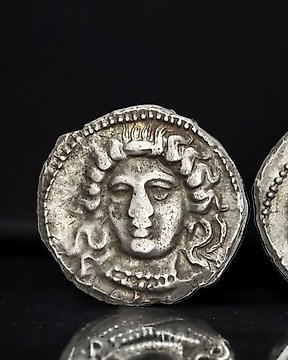
Cilicia, Tarsos. Stater 384-361 BC
Nr. 85124051

Nr. 85124051

THRACE, ISTROS, stater, no date (400-350 BC), Obverse: 2 faces facing, on left is right side up, on right is upside down, Reverse: eagle on dolphin L, ΙΣΤΡΙ, ΑΠ monogram below, silver, 17mm, 6.17g, SG1669, XF+
Istros (Histia, Sinoe) was a Greek colony on the western shore of the Black Sea in Romania near the mouth of the Danube River, which was called the Istros River back then.
Thrace is the land between the Balkan mountains and the Black Sea from northern Greece to southern Bulgaria and European Turkey. The ancient Thracians are thought to have been indigenous, meaning, I suppose, that they were there at least as far back as the neolithic period, before the invention of history. The ancient and extinct Thracian language is “generally agreed” to be Indo-European, which is supposed to mean that they came from somewhere else. During the early coin period the coins of Thrace were mostly made by Greek colonists.
We think that our culture grew out of the culture of Greece because it was in Greece (and in China) that people started thinking about how things could be different than they were in a world where everything was dangerous and might made right. They also established principles of artistic expression that we still use today. We see this approach to art in their coins.
Ancient Coins includes Greek and Roman coins and those of neighbors and successors, geographically from Morocco and Spain all the way to Afghanistan. Date ranges for these begin with the world’s earliest coins of the 8th century BC to, in an extreme case, the end of Byzantine Empire, 1453 AD.
Zo koop je op Catawiki
1. Ontdek iets bijzonders
2. Plaats het hoogste bod
3. Veilig betalen